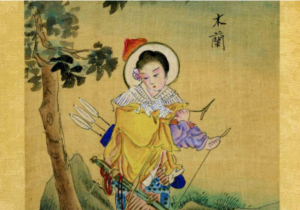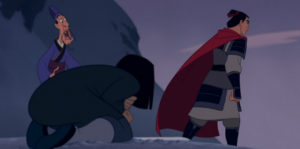17
Difference, Power, and Discrimination in Mulan (1998)
By Andrew Arnold
Disney films are notorious for a repetitive and consistent outline and plot line for their animated films. Most often we see some characters have difficulties at home, and often at odds with their parent(s) or guardian(s), they strike it out on their own to prove themselves, and oftentimes, save the place or the people they love from certain demise. From the get-go, Mulan (1998), seems no different. Yet this movie, more fluidly and elegantly than any other Disney flick I’ve seen, captures that same idea but also captures a respect for the way things are, even if they’re not the way our protagonist wants them to be. It’s in this dichotomy of progression and respect that Mulan dictates a commanding and virtuous display of representing, interpreting, and championing issues of difference, power, and discrimination that the western world faced at the time of its creation, and even still today. The character Mulan displays an effort to recognize major areas of societal difference in gender roles, change the perspective of what power means, and challenge the forms of societally-based discrimination faced by women, and non-cisgendered people.
The story of Fa Mulan in the film Mulan is based upon actual Chinese legend. Film critic Roger Ebert, in his review of “Mulan,” writes, “The story this time isn’t a retread of a familiar Western children’s classic, but based on a Chinese folk tale about a plucky Chinese teenage girl who disguises herself as a boy to fight the invading Huns.” Lan Dong in his book entitled, Mulan’s Legend and Legacy in China and the United States, describes how our beloved animated Mulan stems from, “The Ballad of Mulan” in popular folklore. Disney was at the crossroads of upholding Chinese culture and meaning but westernizing the film to be digestible for the American family, and the expectations of a typical Disney movie.

With the Disney Revolution of the 1990s, and growing political processes to support minority group representation, this is especially true. How could Mulan follow this trend and also be a beloved children and family flick? Ebert said it best, “The outcome manages somehow to be true simultaneously to feminist dogma and romantic convention.” Mulan’s journey of taking her life into her hands, stepping into places she should not go, avoiding the traditional matchmaking process, and yet still falling for the charming, heroic, masculine man. Mulan does give the best of both worlds.
In terms of labeling differences of roles, gender, norms, and capability, Mulan hits all the boxes. In, “How Disney’s Mulan Brazenly Challenges Gender and Sexuality,” Soren Hough details this relationship, stating, “We saw non-traditional families, people of color in lead roles and a general break from the norms of Disney princess storytelling. This new art was an essential part of growth for a generation that is more fluid.” Mulan, as a Chinese woman, brings to the picture a different cultural system from what the western world understands and allows Mulan to challenge this culture. Yet, Mulan does not altogether reject this culture. She still respects and honors those who came before and those who are not her. Lan Dong writes, “Instead of being miserable victims or unusual radicals these women are agents ‘who embraced certain aspects of official norms while resisting others.’” This method of acceptant rejection is a new trope to Disney films, and a new trope in many ways to our own society. There is beauty in the past and tradition, but also courage and belonging in the brand new.
The symbolism of power within the film is uniquely displayed not only in its literary aspects, but also in the cinematography of key scenes. Mulan herself sought out power: to be seen as a man, strong and capable, and to bring honor. Even this concept of masculinity is challenged. Masculinity as a marker is redefined by Li Shang, her commanding officer of war, during the famous “I’ll Make a Man Out of You” track and montage. Shang transforms the burly, aggressive, “masculine” men into disciplined warriors: people willing to fight with honor and die for their people. Late in the film, however, Mulan once again adjusts this concept. Hough discusses this transition of power tropes by stating how Mulan used wit rather than raw might. She found power in herself, rather than the standards of power placed ahead of her. At the end of the film, Mulan concocts a plan that involves the raw, masculine warriors dressing femininely to outwit the opposition. This is clearly a bit of a reversal of roles in a comedic manner, but it works to perfection. There is no lost honor in this gender-blurring act, and no less power within femininity.

The most pivotal of scenes comes in the revealing of Mulan’s true identity. She is dragged out of her tent and cast aside by the consular. She is shamed and disregarded. As it is explained, the penalty for her actions is death. Herein lies the biggest moment of power transition. The camera completely flips from a very frontal, level, and bright atmosphere and focus, to a very dark, depth extending, angled picture. We see Shang tower over Mulan in a larger-than-life pose. In most frames we see Mulan huddled under the blanket and her own shame, with a slightly out-of-focus Shang, his back turned, and his respect and trust for her lost. The music transitions to dramatic, rhythmic, cadence. This all builds to the climactic moment of Shang casting down his sword before her rather than striking her down as would have been his duty. Whilst clearly he lost his respect for her as a liar, he respected her, still, as a human, and as a human, he was indebted to: “A life for a life.” We find Mulan has, even in her weakness, accessed power due to her courage and bravery. She has earned her life.

Discrimination is the most key social point to the film. In the final scenes, Mulan returns to Shang in the Chinese capital to warn him of the surviving Huns. This holds key dialogue for the nature of discrimination, not just diegetically, but non-diegetically too. Shang tells Mulan, “You don’t belong here.”
“Shang, I saw them in the mountains. You have to believe me.” Mulan replies. “Why should I?”
“Why else would I come back? You said you trust Ping, why is Mulan any different?” This is the major point Mulan and the film as a whole are making. Mulan stepped out of her place, even crossing gender lines, tradition, and literal Chinese law to do what’s right. Here she is once again doing her best to serve the people she cares about and is once more cast aside. How is she regarded differently than a man? Why should this be so?
Ultimately this comes full circle by the very end of the film. Mulan returns to her father with the emblem of the emperor and Shan Yu’s sword. These are the highest symbols of the highest accomplishments. These surely would bring her father honor as she so desperately desired to do. But he casts them aside with the closing line, “The greatest gift and honor, is having you for a daughter.” Finally, her value is seen. Not for being a man, not for her accomplishments, but for her value as a daughter. Simply someone who deserves to be loved. This is where the conjunction of Chinese tradition and honor, and western ideas and focuses find their meeting ground. Mulan has pushed these boundaries but ultimately finds her way back home once more. Even Shang returns to pursue her as a love interest. Now she is not only the progressive, independent, butt-kicking, woman, but the traditional romantic who still gets the guy in the end.
The messages and themes of Mulan did not strike so resonantly with every viewer, however. Johnson Cheu’s book, an anthology with many other authors, entitled, Diversity in Disney Films: Critical Essays on Race, Ethnicity, Gender, Sexuality and Disability, discusses DPD issues and how they are portrayed in many Disney films. The section regarding Mulan is co-authored by Gwendolyn Limbach. An excerpt reads, “Rather than blurring the boundaries between genders, Disney’s Mulan continually differentiates men and women through ‘axiomatic’ concepts of what is female and what is male.” Cheu and Limbach felt that in an attempt to generate an acceptance for gender progression and non-traditionality, they inadvertently further deepened these defining lines. They go on to argue that a true blurring of these defined lines would not be layered in conjunction with several scenes: strictly defining man, woman, and their expected roles. In fact, in each moment of gender “swapping,” it is clear that this is a dramatic shift from one side to the other, and not a spectrum-esque leaning between. This does bring the perspective that in accordance with gender roles, the film does well to progressively adjust, but in gender-binary focused thinking, the film further solidifies more traditional ideas.
Mulan has always been a personal favorite Disney Princess movie. It avoids a lot of the sickly-sweet blind romance tropes of films like Sleeping Beauty and Cinderella. Instead, Mulan offers a look into an interesting and new culture. While it is westernized in plot, there is very tangible and meaningful respect given to the origins of the film and the traditional Chinese culture it represents. While we might have a negative reaction to non-western themes like matchmaking, and conscription, Mulan challenges these themes but does not disgrace these ideas. In fact, it teaches that there is honor in these traditions, not shame. Mulan does not put disgrace on its origins. This is so refreshing for Disney. There are few things better than an action-packed, but character-focused, plotline with climax and meaning, not to mention some of the catchiest Disney tracks you’ll ever hear.
While Mulan is a family film, understandable and simplistic enough for the youngest of viewers, there is depth and meaning in the story. There is a harmonious intertwining of cultural and societal ideas. We see traditional Chinese culture meet modern, western romanticism. We see tradition and honor meet progression and courage. We see power in oneself and power in unity. Most of all we see truth, beauty, and meaning in the simplest of stories, and the most complex of moralities. Mulan offers the grand yet subtle displays of difference, power, and discrimination, through one character’s hard decision. How can you bring honor to who you are? How can we truly see who we are? How can who we are meet who we are meant to be? Fa Mulan has plenty to show us.
References
Cheu, Johnson. Diversity in Disney Films: Critical Essays on Race, Ethnicity, Gender, Sexuality and Disability. McFarland & Co., 2013.
Dong, Lan. Mulan’s Legend and Legacy in China and the United States. Temple University Press, 2011.
Ebert, Roger. “Mulan Movie Review & Film Summary (1998).” Roger Ebert.com, 19 June 1998, https://www.rogerebert.com/reviews/mulan-1998.
Failes, Ian. “The CG Side of the Animated ‘Mulan’.” Befores & Afters, 29 Sept. 2020, https://beforesandafters.com/2020/09/26/the-cg-side-of-the-animated-mulan/#:~:text=The %20film%20was%20animated%20in,the%20free%20open%2Dsource%20software.
Hough, Soren. “How Disney’s ‘Mulan’ Brazenly Challenges Gender and Sexuality: Features.” Roger Ebert.com, 28 Dec. 2016, https://www.rogerebert.com/features/how-disneys-mulan-brazenly-challenges-gender-and-sexuality.
Rowney, Jo-Anne. “Is Disney’s Mulan Based on a True Story? Meet Hua Mulan, the Chinese Warrior.” Is Mulan Based on a True Story? Real History behind Disney’s Movie | Radio Times, Radio Times, 21 Sept. 2021, https://www.radiotimes.com/movies/mulan-disney-true-story-hua-ballad/.

